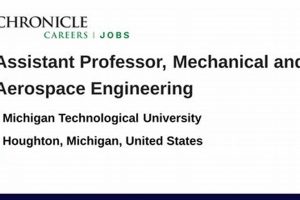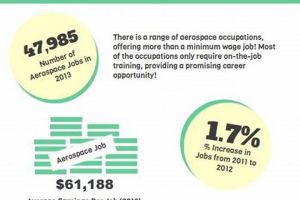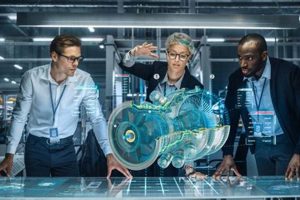Positions within the sectors responsible for designing, developing, manufacturing, and maintaining aircraft, spacecraft, and military systems represent a crucial segment of the global economy. These roles encompass a wide spectrum of activities, from fundamental research and engineering to logistical support and project management, demanding highly specialized skillsets and expertise. For instance, a structural engineer might be tasked with designing the airframe of a new commercial airliner, or a software developer might create the guidance system for a missile defense platform.
The significance of these professional opportunities extends beyond economic contributions. Innovation within these industries frequently drives advancements in materials science, computing, and other technological domains, with widespread applications benefiting society as a whole. Historically, investment in these areas has been a catalyst for scientific breakthroughs and the development of advanced manufacturing techniques. Moreover, these careers often provide significant opportunities for professional growth, stability, and the chance to contribute to national security or cutting-edge technological progress.
The following sections will delve into specific career paths, necessary qualifications, and the evolving landscape shaping professional opportunities in these technically demanding fields.
Guidance for Pursuing Opportunities in Relevant Industries
The pursuit of a successful career in these technologically advanced and strategically important sectors requires careful planning and focused effort. The following guidance provides key considerations for individuals seeking to enter or advance within these domains.
Tip 1: Acquire Specialized Education: A strong foundation in engineering, computer science, physics, or a related field is generally essential. Consider advanced degrees or certifications specific to aerospace or defense technologies. For example, a master’s degree in aerospace engineering with a focus on propulsion systems is highly advantageous for related roles.
Tip 2: Develop Technical Proficiency: Cultivate expertise in relevant software, hardware, and analytical tools. Proficiency in CAD/CAM software, simulation tools, or programming languages like C++ or Python is frequently required. Regularly update skills to keep pace with technological advancements.
Tip 3: Seek Relevant Experience: Internships, co-op programs, or entry-level positions in related industries provide valuable hands-on experience. Working on projects involving aircraft design, satellite development, or military systems offers practical knowledge and networking opportunities.
Tip 4: Obtain Security Clearances: Many positions, particularly within the defense sector, require security clearances. Understand the requirements and initiate the application process early, as it can be lengthy and involve background checks. A secret or top-secret clearance can significantly expand career prospects.
Tip 5: Network Strategically: Attend industry conferences, join professional organizations, and connect with individuals working in these fields. Networking provides insights into job openings, industry trends, and potential mentors. Active participation in organizations like the American Institute of Aeronautics and Astronautics (AIAA) can be beneficial.
Tip 6: Emphasize Problem-Solving Skills: Showcase the ability to analyze complex problems, develop innovative solutions, and work effectively in team environments. Aerospace and defense projects often involve intricate challenges requiring collaborative problem-solving abilities. Demonstrating this skillset is crucial during the interview process.
Tip 7: Stay Informed on Industry Trends: Continuously monitor developments in aerospace and defense technologies, including advancements in artificial intelligence, cybersecurity, and unmanned systems. Staying current demonstrates a commitment to the field and positions individuals as knowledgeable candidates.
Adherence to these guidelines significantly enhances the likelihood of securing and succeeding in highly competitive professional environments. Diligence and a commitment to continuous learning are essential for long-term career progression.
The subsequent sections will examine the future outlook and emerging trends impacting the demand for qualified professionals in the industries discussed.
1. Engineering Expertise
Engineering expertise forms the bedrock upon which the aerospace and defense industries operate. It is not merely a desirable attribute, but a fundamental requirement for the design, development, and maintenance of complex systems that define these sectors. This expertise encompasses a wide range of disciplines and specializations, each playing a critical role in ensuring the safety, efficiency, and effectiveness of aerospace and defense technologies.
- Aerospace Systems Design
Aerospace systems design focuses on creating aircraft, spacecraft, satellites, and related components that meet stringent performance and safety standards. This involves aerodynamic analysis, structural integrity assessment, and the integration of various subsystems, such as propulsion, avionics, and control systems. Engineers in this area must possess a deep understanding of fluid dynamics, materials science, and control theory to optimize performance and minimize risk. For example, the design of a new generation fighter jet requires engineers to balance speed, maneuverability, and stealth capabilities while adhering to strict weight and cost constraints.
- Defense Systems Engineering
Defense systems engineering involves the design, development, and testing of military systems, including weapons, communication networks, and surveillance technologies. This area demands expertise in signal processing, cryptography, and electronic warfare. Engineers must also consider the operational environment and potential threats when designing these systems. The development of a secure communication network for battlefield operations, for instance, requires engineers to design systems that are resistant to jamming, interception, and cyberattacks.
- Materials Science and Engineering
Materials science and engineering focuses on the development and application of advanced materials with specific properties for aerospace and defense applications. This includes lightweight composites, high-strength alloys, and heat-resistant materials. Engineers in this area must have a thorough understanding of material properties, manufacturing processes, and testing methods. The use of carbon fiber reinforced polymers in aircraft structures, for example, reduces weight, improves fuel efficiency, and enhances corrosion resistance.
- Software and Systems Integration
Software and systems integration involves the development and integration of software applications and hardware components into complex aerospace and defense systems. This area requires expertise in software engineering, real-time operating systems, and data communication protocols. Engineers must ensure that all components work seamlessly together to achieve the desired functionality. For example, the integration of radar sensors, navigation systems, and autopilot functions in an unmanned aerial vehicle requires sophisticated software and system integration capabilities.
The various facets of engineering expertise outlined above are inextricably linked to the successful functioning of the aerospace and defense industries. Without a strong foundation in these core engineering principles, the design, development, and deployment of advanced aerospace and defense technologies would be impossible. These industries rely on the continuous innovation and problem-solving capabilities of highly skilled engineers to maintain a competitive edge and ensure national security.
2. Technological Innovation
Technological innovation serves as the primary engine driving advancement and creating opportunities within the aerospace and defense sectors. The constant pursuit of enhanced capabilities, improved efficiency, and novel solutions necessitates a continuous stream of innovation, directly impacting the skills and expertise required for associated professional roles. This creates a demand for professionals capable of not only understanding but also contributing to cutting-edge developments. The development of stealth technology, for instance, required breakthroughs in materials science, radar absorbent materials, and aerodynamic design, thereby creating new roles for materials scientists, radar engineers, and aeronautical engineers. Similarly, the ongoing development of hypersonic weapons systems necessitates expertise in areas such as high-temperature materials, advanced propulsion systems, and computational fluid dynamics.
The effect of technological innovation is multifaceted, impacting not only the technical aspects of the industries but also the operational strategies and global competitiveness. Consider the shift toward unmanned aerial vehicles (UAVs), or drones. This has fueled growth in areas like AI, sensor technology, and cybersecurity. Consequently, professionals skilled in these domains are increasingly vital to the design, development, and deployment of UAV systems for surveillance, reconnaissance, and even combat roles. Furthermore, the integration of artificial intelligence and machine learning into defense systems is creating demand for professionals who can develop and implement these technologies, ensuring systems are effective, secure, and ethical. The practical significance lies in maintaining a technological advantage. Countries that prioritize innovation within these sectors are better positioned to address emerging threats and protect their national interests.
In summary, technological innovation forms an indispensable component of professional roles within aerospace and defense. It necessitates a commitment to continuous learning and adaptation, requiring professionals to stay abreast of the latest advancements and acquire new skills. The challenges lie in managing the rapid pace of technological change, ensuring that education and training programs remain aligned with industry needs, and fostering a culture of innovation that encourages experimentation and risk-taking. Ultimately, the successful integration of technological innovation into aerospace and defense jobs is crucial for maintaining security, driving economic growth, and ensuring global competitiveness.
3. Security Requirements
Stringent security requirements represent an intrinsic element of professional roles within the aerospace and defense industries. This connection arises directly from the sensitive nature of the technologies, data, and infrastructure involved. A causal relationship exists: the critical importance of safeguarding national security and proprietary information necessitates stringent protocols and vetting processes. The failure to adhere to these requirements can result in severe consequences, including compromised systems, espionage, and potential threats to national security. Therefore, understanding and complying with security regulations is not merely a procedural formality but a fundamental job requirement.
The practical implications of these requirements are extensive. Many positions, particularly those involving classified projects, necessitate security clearances granted by governmental agencies. These clearances involve thorough background checks, encompassing criminal history, financial records, and personal associations. For example, an engineer designing cryptographic algorithms for secure military communications must typically hold a top-secret clearance. Furthermore, access to certain facilities and data is often restricted based on the “need-to-know” principle, limiting access to only those individuals with a legitimate professional requirement. Compliance also extends to handling sensitive data in accordance with strict protocols, preventing unauthorized disclosure or access.
In summary, security requirements are not ancillary considerations but rather integral components of aerospace and defense positions. They are driven by the need to protect vital national interests and proprietary technologies. Challenges include adapting to evolving cybersecurity threats and maintaining a balance between security and operational efficiency. A comprehensive understanding of these security protocols is essential for any individual seeking a career within these sectors.
4. Global Collaboration
The interconnected nature of the modern world necessitates collaborative efforts across international borders, significantly influencing the landscape of professional opportunities. Such partnerships are increasingly vital for addressing complex challenges, leveraging diverse expertise, and managing the costs associated with advanced technological development.
- International Partnerships in Research and Development
Collaborative ventures in research and development allow nations to pool resources and knowledge, fostering innovation and accelerating the pace of technological progress. For instance, the development of the Eurofighter Typhoon involved the cooperative efforts of multiple European nations, sharing engineering expertise and manufacturing capabilities. This approach allows for the distribution of risk and cost, while also benefiting from the diverse perspectives and skillsets of international teams. These collaborative projects create professional opportunities for engineers, scientists, and project managers with cross-cultural communication skills and technical expertise relevant to the specific project.
- Supply Chain Integration Across Borders
The manufacturing of complex systems typically involves intricate global supply chains, with components sourced from various countries. This necessitates effective coordination and logistics across borders, creating roles in supply chain management, international trade, and quality control. A commercial aircraft, for example, may have engines manufactured in one country, avionics produced in another, and the airframe assembled in a third. Professionals in these positions must navigate complex regulatory environments, manage international logistics, and ensure adherence to stringent quality standards.
- Joint Ventures for Market Access and Expansion
Companies often form joint ventures to gain access to new markets or expand their global footprint. These ventures require professionals with expertise in international business development, marketing, and legal compliance. Joint ventures enable companies to share resources, mitigate risk, and leverage the local knowledge and expertise of their partners. For instance, a company seeking to sell military equipment to a foreign government may partner with a local firm to navigate the regulatory landscape and build relationships with key stakeholders. Professionals in these roles must possess strong communication and negotiation skills, as well as a deep understanding of international business practices.
- Standardization and Interoperability Initiatives
Global collaboration is also crucial for establishing common standards and ensuring interoperability of systems. Organizations like NATO play a vital role in defining standards for military equipment and communication protocols, facilitating interoperability between allied forces. Professionals involved in standardization initiatives require expertise in engineering, systems integration, and international relations. The adoption of common standards reduces costs, enhances operational effectiveness, and promotes collaboration between nations. For example, the development of standardized communication protocols allows military forces from different countries to communicate seamlessly during joint operations.
These collaborative efforts highlight the increasingly globalized nature of related sectors, demanding a workforce equipped with cross-cultural communication skills, technical expertise applicable in international contexts, and adaptability to diverse operating environments. Professionals who can effectively navigate these complexities are highly valued, contributing to the success of international partnerships and the advancement of global security.
5. Advanced Manufacturing
Advanced manufacturing plays a pivotal role in the aerospace and defense sectors, driving innovation, enhancing efficiency, and ensuring the production of high-quality, reliable systems. The sophisticated technologies and processes employed in advanced manufacturing are directly intertwined with the skillsets and expertise demanded in related professional opportunities.
- Additive Manufacturing (3D Printing)
Additive manufacturing, commonly known as 3D printing, allows for the creation of complex geometries and customized components with minimal material waste. In aerospace, this technology facilitates the production of lightweight structural components, engine parts, and specialized tooling. For example, GE Aviation utilizes additive manufacturing to produce fuel nozzles for its LEAP engines, reducing weight and improving fuel efficiency. This technology necessitates professionals skilled in CAD/CAM software, materials science, and process optimization.
- Robotics and Automation
The integration of robotics and automation in manufacturing processes enhances precision, reduces labor costs, and improves safety. In defense manufacturing, robots are employed for tasks such as welding, painting, and assembling munitions. Lockheed Martin utilizes robotic systems for the assembly of F-35 fighter jets, increasing production efficiency and ensuring consistent quality. This necessitates skilled robotics technicians, automation engineers, and programmers to design, maintain, and optimize these systems.
- Advanced Materials Processing
Advanced materials processing involves the use of sophisticated techniques to manipulate and shape materials with enhanced properties. This includes processes like laser cutting, electron beam welding, and chemical vapor deposition. Aerospace manufacturers use advanced materials processing to create high-strength, lightweight components from materials like titanium, carbon fiber composites, and nickel alloys. Boeing, for example, employs laser cutting to produce precise components for its aircraft structures. Professionals in this area require expertise in materials science, metallurgy, and process engineering.
- Digital Manufacturing and Data Analytics
Digital manufacturing leverages data analytics, simulation, and modeling to optimize manufacturing processes and improve product quality. By collecting and analyzing data from sensors and machines, manufacturers can identify bottlenecks, predict failures, and improve efficiency. Airbus utilizes digital twins to simulate aircraft performance and optimize manufacturing processes. Professionals in this domain require skills in data science, statistical analysis, and machine learning to develop and implement these digital manufacturing solutions.
The synergy between advanced manufacturing and aerospace and defense opportunities underscores the growing demand for a highly skilled workforce capable of leveraging these technologies. As manufacturing processes become more sophisticated, the need for professionals with expertise in additive manufacturing, robotics, advanced materials, and data analytics will continue to increase, driving innovation and competitiveness in these critical sectors.
6. Research and Development
Research and Development (R&D) forms the intellectual and technological cornerstone of the aerospace and defense industries. It directly fuels innovation, propels technological advancement, and ultimately shapes the nature and scope of professional opportunities within these sectors.
- Fundamental Scientific Research
Fundamental scientific research provides the foundational knowledge upon which technological breakthroughs are built. This includes exploring new materials, understanding complex physical phenomena, and developing novel theoretical frameworks. For example, research into hypersonic aerodynamics has led to advancements in vehicle design and propulsion systems, creating opportunities for fluid dynamics specialists, materials scientists, and aerospace engineers. These roles involve conducting experiments, analyzing data, and publishing findings that contribute to the broader scientific knowledge base.
- Applied Research and Technology Development
Applied research focuses on translating fundamental scientific discoveries into practical applications. This includes developing new technologies, refining existing systems, and addressing specific technological challenges. For instance, research into advanced sensors has resulted in the development of improved radar systems, creating opportunities for electrical engineers, signal processing specialists, and software developers. These professionals work to prototype, test, and refine technologies, bridging the gap between theory and practical implementation.
- Experimental Prototyping and Testing
Experimental prototyping and testing are crucial for validating new technologies and ensuring their performance in real-world conditions. This involves building prototypes, conducting simulations, and performing field tests. For example, testing of unmanned aerial vehicles (UAVs) requires skilled test pilots, flight engineers, and data analysts to collect and interpret performance data. These professionals work to identify potential issues, optimize system performance, and ensure compliance with safety and regulatory requirements.
- Technology Integration and System Optimization
Technology integration involves incorporating new technologies into existing systems and optimizing overall system performance. This requires a deep understanding of system architecture, software integration, and hardware compatibility. For example, integrating advanced artificial intelligence algorithms into military communication networks requires skilled software engineers, cybersecurity specialists, and network architects. These professionals work to ensure seamless integration, enhanced functionality, and improved security.
In conclusion, R&D is inextricably linked to the vitality and evolution of professional paths within aerospace and defense. The continuous pursuit of new knowledge, technological advancements, and system improvements drives the demand for highly skilled professionals with expertise in a wide range of scientific and engineering disciplines.
7. Strategic Importance
The inherent link between national security and technological advantage establishes the aerospace and defense sectors’ strategic importance. Governmental bodies and private organizations prioritize these industries because the development and deployment of advanced systems are vital for maintaining a competitive edge in global power dynamics. This prioritization directly influences the allocation of resources, creating a consistent demand for specialized professionals. Consequently, positions in aerospace and defense are not merely occupations but integral components of a nation’s strategic posture. For instance, the development of advanced missile defense systems necessitates a workforce skilled in radar technology, cybersecurity, and systems engineering, reflecting the critical role these professionals play in safeguarding national borders. The same applies to the design and production of advanced fighter aircraft, unmanned aerial vehicles, and secure communication networks, each requiring a cadre of experts vital to a country’s ability to project power and protect its interests.
The strategic importance of these sectors also extends beyond military applications. Space exploration, for example, is crucial for scientific discovery, resource management, and national prestige. Professionals working in space-related roles contribute to advancements in satellite technology, remote sensing, and planetary exploration, benefiting both scientific knowledge and practical applications like weather forecasting and global communication. Similarly, advancements in commercial aviation impact economic growth, facilitating global trade and tourism. The engineers, scientists, and technicians who design and maintain these systems contribute directly to the interconnectedness of the global economy and the advancement of societal well-being. Understanding this intrinsic strategic importance allows for informed career decisions, enabling individuals to align their skills with fields vital to national and global objectives.
In summary, the strategic importance of aerospace and defense generates sustained investment and innovation, leading to continuous professional opportunities across a wide spectrum of disciplines. The challenge lies in attracting and retaining highly skilled individuals in these fields, requiring a commitment to education, training, and competitive compensation. Acknowledging this fundamental link between national security and technological advancement is crucial for both policymakers and prospective professionals seeking to contribute to the advancement of human knowledge and the safeguarding of national interests.
Frequently Asked Questions Regarding Aerospace and Defence Jobs
The following section addresses common inquiries concerning professional pathways, qualifications, and industry trends within the aerospace and defense sectors. These responses aim to provide clear, concise, and factual information to individuals considering or currently pursuing relevant career opportunities.
Question 1: What educational qualifications are typically required to secure a position in the aerospace and defense industries?
A bachelor’s degree in engineering (aerospace, mechanical, electrical, etc.), computer science, physics, or a related field is generally considered the minimum requirement. Certain specialized roles may necessitate advanced degrees (master’s or doctoral) or professional certifications. The specific educational background will depend on the particular role, with research-intensive positions often requiring higher levels of academic attainment.
Question 2: What are the most in-demand skills for individuals seeking employment in these sectors?
Skills in high demand include proficiency in CAD/CAM software, programming languages (C++, Python), data analysis, systems engineering, and project management. Knowledge of relevant regulatory frameworks and security protocols is also highly valued. Adaptability, problem-solving abilities, and effective communication skills are essential for success in collaborative project environments.
Question 3: Are security clearances always required for aerospace and defense positions?
The necessity for a security clearance depends on the specific role and the nature of the work involved. Positions working with classified information or sensitive technologies typically require a security clearance. The level of clearance required (e.g., Secret, Top Secret) is determined by the sensitivity of the information being accessed.
Question 4: What is the job outlook for aerospace and defense occupations in the coming years?
The job outlook for many aerospace and defense occupations is projected to be stable or grow moderately in the coming years. This is driven by factors such as ongoing defense spending, technological advancements, and increasing demand for air travel and space exploration. However, the specific outlook may vary depending on the occupation and geographic location.
Question 5: How can individuals gain relevant experience to enhance their career prospects in these industries?
Internships, co-op programs, and entry-level positions in related fields provide valuable hands-on experience. Participating in industry-specific projects, attending conferences, and joining professional organizations can also enhance an individual’s knowledge and network. Continuous learning and professional development are essential for keeping pace with technological advancements.
Question 6: What are some emerging trends that are shaping the future of aerospace and defense jobs?
Emerging trends include the increasing adoption of artificial intelligence, automation, and additive manufacturing. Cybersecurity threats are also driving demand for professionals with expertise in data protection and network security. Furthermore, the growing focus on sustainability and environmental impact is creating opportunities in areas such as electric propulsion and alternative fuels.
This FAQ section aims to provide a foundational understanding of key aspects associated with these jobs. Continuously monitoring industry trends and adapting skills will be crucial for long-term career success.
The subsequent article section will delve into career paths and the evolving landscape shaping relevant opportunities.
Aerospace and Defence Jobs
This exploration has underscored the multifaceted nature of aerospace and defence jobs, emphasizing the pivotal roles these sectors play in both national security and technological advancement. The demand for specialized expertise in engineering, technological innovation, security protocols, global collaboration, advanced manufacturing, and research and development is consistently driven by the strategic importance these industries hold. Furthermore, a commitment to continuous learning and adaptation remains essential for professionals seeking to thrive within this dynamic landscape.
As technology continues to evolve and geopolitical landscapes shift, the need for skilled individuals in these domains will only intensify. Individuals are encouraged to leverage the insights provided herein to inform career paths and contribute to the ongoing advancement of these critical sectors. The future trajectory of these industries depends on a workforce prepared to meet emerging challenges and drive innovation forward.







